Object Le Dãƒâ©jeuner en Fourrure Meret Oppenheim Ap Art History
Meret Oppenheim,Object, 1936, fur-covered cup, saucer, and spoon, loving cup 4–three/8″ in diameter; saucer 9–3/8″ in diameter; spoon 8″ long, overall height 2–7/eight″ (The Museum of Modern Art). Speakers: Dr. Steven Zucker and Dr. Beth Harris
A Lunch with Fur
The story behind the creation of Object, an ordinary cup, spoon, and saucer wrapped evocatively in gazelle fur, has been told so many times its importance in modernist history transcends the fact it might be counterfeit (of dubious authenticity). The xx-two twelvemonth onetime Basel-born artist, Meret Oppenheim, had been in Paris for iv years when, ane day, she was at a café with Pablo Picasso and Dora Maar. Oppenheim was wearing a contumely bracelet covered in fur when Picasso and Maar, who were admiring information technology, proclaimed, "Almost anything can be covered in fur!" As Oppenheim'southward tea grew common cold, she jokingly asked the waiter for "more fur." Inspiration struck—Oppenheim is said to have gone direct from the café to a store where she purchased the cup, saucer, and spoon used in this piece. This agreeable story belies the importance of Object and the critical acclaim and public fascination that has elevated it to indicate where it has become the definitive surrealist object…ultimately to Oppenheim's dismay.
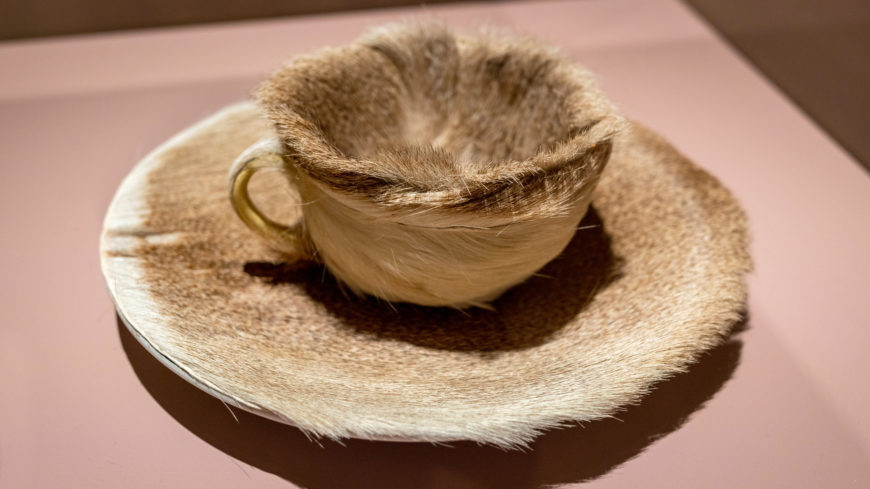
Loving cup particular, Meret Oppenheim,Object, 1936, fur-covered cup, saucer, and spoon, cup 4–3/8″ in bore; saucer 9–three/viii″ in diameter; spoon viii″ long, overall height 2–7/viii″ (The Museum of Mod Art, New York; photograph: Steven Zucker, CC BY-NC-SA 2.0)
What Is a Surrealist Object?
Oppenheim's Object was created at a moment when sculpted objects and assemblages had become prominent features of Surrealist fine art practice. In 1937, British art critic Herbert Read emphasized that all Surrealist objects were representative of an idea and Salvador Dalí described some of them as "objects with symbolic function." In other words, how might an otherwise typical, functional object be modified so information technology represents something deeply personal and poetic? How might information technology, in Freudian terms, resonate every bit a sublimation of internal desire and aspiration? Such concrete manifestations of our internal psyches were indicative of a surreality, or the point in which external and internal realities united, as described by André Breton (one of Surrealism's founders and theorists) in his first Manifesto of Surrealism.

Spoon detail, Meret Oppenheim,Object, 1936, fur-covered loving cup, saucer, and spoon, cup 4–3/8″ in diameter; saucer 9–3/8″ in diameter; spoon viii″ long, overall height 2–vii/viii″ (The Museum of Modern Fine art, New York; photo: Steven Zucker, CC By-NC-SA 2.0)
Visceral Responses
What, then, do we make of this fix of exist-furred tableware? Interpretations vary wildly. The art historian Whitney Chadwick has described it equally linked to the Surrealist's love of alchemical transformation by turning cool, shine ceramic and metal into something warm and bristley, while many scholars have noted the fetishistic qualities of the fur-lined set up—as the fur imbues these functional, hand-held objects with sexual connotations.
In a 1936 consequence of the New Yorker Magazine, it was reported that a woman fainted "right in front of the fur-bearing loving cup and saucer [while it was on exhibit at MoMA]. "She left no name with the attendants who revived her – only a vague feeling of apprehension."1 Such visceral reactions to Oppenheim's sculpture come closest, perhaps, to what were probable the artist's aspirations. In an interview subsequently in life, Oppenheim described her creations every bit "non an illustration of an idea, but the thing itself."
Unlike Read and Dalí, Oppenheim stresses the physicality of Object, reinforcing the manner we tin readily imagine the feeling of the fur while drinking from the cup, and using the saucer and spoon. The frisson we experience when red china is unexpectedly wrapped in fur is based on our familiarity with both, and the fur requires u.s. to extend our sensory experiences to fully capeesh the piece of work. Object insists we imagine what sipping warm tea from this cup feels like, how the bristles would feel upon our lips. With Oppenheim'due south elegant cosmos, how nosotros empathize those visceral memories, how we create metaphors and symbols out of this act of tactile extension, is entirely open to interpretation past each individual, which is, in many ways, the whole betoken of Surrealism itself.
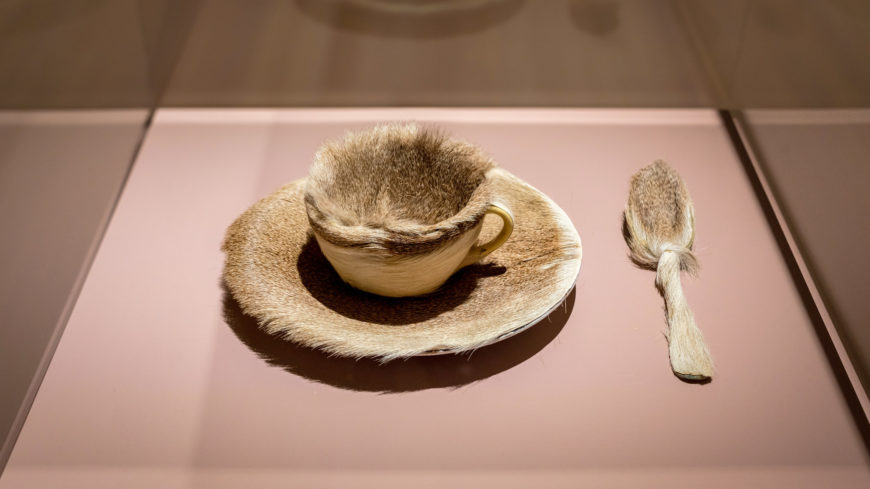
Meret Oppenheim,Object, 1936, fur-covered cup, saucer, and spoon, cup 4–three/8″ in diameter; saucer 9–iii/8″ in bore; spoon 8″ long, overall height 2–vii/eight″ (The Museum of Modernistic Art, New York; photo: Steven Zucker, CC BY-NC-SA two.0)
Presentation Problems
In spite of our individual response, the estimation of Object has been complicated by the ways information technology was assigned meaning past others. When Object was finished, Oppenheim submitted it to Breton for an exhibition of Surrealist objects at the Charles Ratton Gallery in Paris in 1936. Nevertheless, while Oppenheim preferred a non-descriptive title, Breton took the freedom of titling the piece Le Déjeneur en fourrure, or Tiffin in Fur. This title is a play on two nineteenth-century works: Édouard Manet'due south infamous modernist painting Lunch on the Grass (Le Déjeneur sur l'herbe) and Leopold von Sacher-Masoch's erotic novel Venus in Furs. With these ii references, Breton forces an explicit sexualized meaning onto Object. Remember that the original inspiration for this work was implicitly practical: when Oppenheim asked the waiter for more than fur for her cooling teacup, it was suggested equally a mode to keep her tea warm, and non necessarily as overtly sexual.
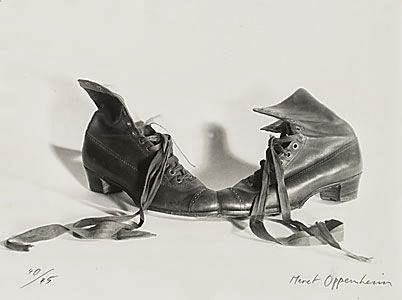
Meret Oppenheim, Das Paar (The Couple), pair of brown shoes attached at the toes, original version 1936, remade 1956
The Pregnant of Others
Certainly we cannot assume that the spark of the idea for this piece and the slice itself are necessarily related, just the way meanings have been ascribed to Oppenheim'south pieces by others has plagued many of her works.
Art historian Edward Powers has noted that when Oppenheim sent her Surrealist object Das Paar to a lensman before submitting it for exhibition, the lensman took the liberty of tying upward the laces before photographing it. When Breton saw the photo with tied laces, he dubbed this object à délacer which in French means to untie, typically either shoes or a corset. The title and laced shoes together suggest the potential act of undressing and a fascination with exposing the female body. All the same, when Oppenheim later described Das Paar (with the laces untied), she stated information technology was an "odd unisexual pair: 2 shoes, unobserved at night, doing 'forbidden' things." She expressly assigned no gender, and suggests the "forbidden" acts already taking place between anthropomorphized shoes. She takes a more literal approach, the shoes as expressive things in themselves, rather than symbolically resonant of something else.
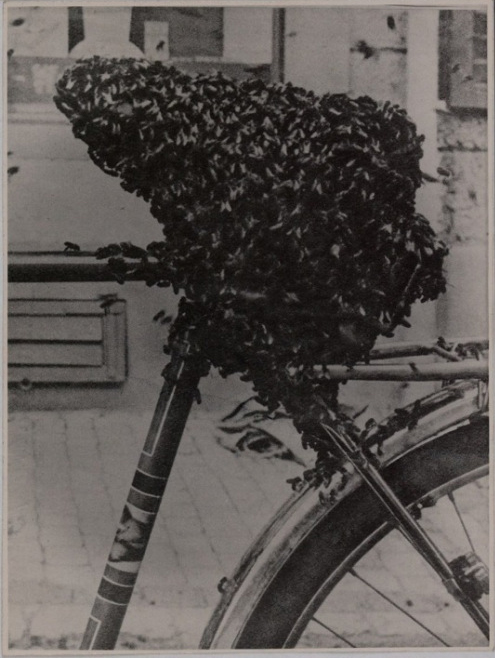
Meret Oppenheim, Bee-covered bike seat, found photo, 1954
This is not to advise that all her interactions with Breton were negative. When she happened across a wonderfully disturbing photograph of a bicycle seat covered in bees, she mailed it to Breton, who republished the found photograph as an creative contribution by Oppenheim in the third effect of the new Surrealist publication Medium.
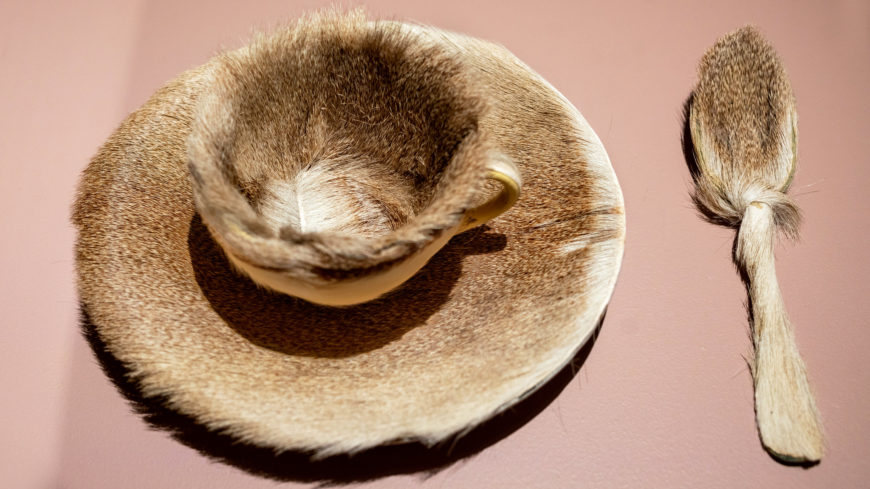
Meret Oppenheim,Object, 1936, fur-covered cup, saucer, and spoon, loving cup 4–three/8″ in diameter; saucer ix–3/viii″ in bore; spoon 8″ long, overall height ii–7/viii″ (The Museum of Modernistic Art, New York; photo: Steven Zucker, CC BY-NC-SA 2.0)
Dangerous Success
Yet, the early acclaim for the fur-covered Object had a negative effect on Oppenheim's early on career. When it was purchased past The Museum of Modern Art and featured in their influential 1936–37 exhibition "Fantastic Fine art, Dada, and Surrealism," visitors alleged it the "quintessential" Surrealist object. And that is how it has been seen always since. But for Oppenheim, the prestige and focus on this one object proved also much, and she spent more than than a decade out of the creative limelight, destroying much of the piece of work she produced during that period. Information technology was merely later when she re-emerged, and began publicly showing new paintings and objects with renewed vigor and confidence, that she began reclaiming some of the intent of her work. When she was given an accolade for her work past the City of Basel, she touched upon this in her acceptance speech communication: "I think it is the duty of a woman to lead a life that expresses her atheism in the validity of the taboos that have been imposed upon her kind for thousands of years. Nobody will requite you liberty; yous take to have it."
1. Nelson Landsdale and St. Clair McKelway, Talk of the Town, "Critical Note," The New Yorker, December 26, 1936, p. 7.
Additional resource
This object at MoMA
Practice quiz on this object
Smarthistory images for didactics and learning:

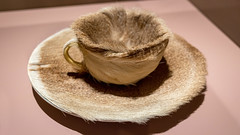

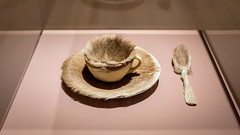
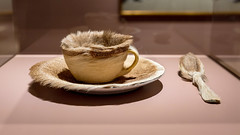
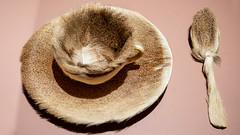
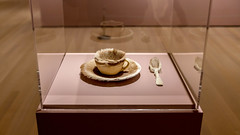
More Smarthistory images…
Source: https://smarthistory.org/meret-oppenheim-object-fur-covered-cup-saucer-and-spoon/
0 Response to "Object Le Dãƒâ©jeuner en Fourrure Meret Oppenheim Ap Art History"
Post a Comment